Formulae Handbook for Class 9 Maths and Science
PS Verma Biology Class 9 Chapter 3 Tissues
Text Book Solutions – P.S.Verma and V.K.Agarwal – Biology
CBSE Class 9 Chapter 3 Tissues
Share Queries and Discuss your Views and Ideas – LearnCBSE Forum
PS Verma and V.K. Agarwal Biology Class 9 Page No – 165.
Solution 1:
Importance of tissues-
(i) Formations of tissues have brought about a division of labour in multicellular organisms.
(ii) Tissues become organised to form organs and organs organise into organ system.
Solution 2:
Plants are autotrophic organisms, so prepare their own food by photosynthesis. Moreover plants are stationary or fixed organisms; they do not have to move from place to place in the search of their food. Since they do not consume or need much energy, so most of the plant tissues are supportive, which provide them with structural strength. Animals are heterotrophic organisms. They have to move in search of food, mate and find shelter, so they need more energy as compared to plants. Most of the tissues they contain are living.
Solution 3:
Plant Tissues
1. They require less maintenance energy.
2. There is a differentiation of meristematic and permanent tissues.
Animal Tissues:
1. They require more maintenance energy.
2. Such a differentiation is absent in them.
Solution 4:
They are located at the base of leaves or internodes, e.g., stems of grasses and other monocots. Such tissues also occur below the nodes. It produces an increase in the length of an organ such as leaves and internodes.
Solution 5:
(i) Apical meristem – It brings about the elongation of the root and stem.
(ii) Lateral meristem – It causes the organ (stem or root) to increase in diameter and girth.
Solution 6:
Simple permanent tissues – These tissues are composed of cells which are structurally and functionally similar.
There are three types of simple permanent tissues:
(i) Parenchyma – Parenchyma cells are living and posses the power of division. The cell wall is thin and encloses a dense cytoplasm which contains a small nucleus and surrounds a large central vacuole.
(ii) Collenchyma – Its tissues consists of living cells. It is characterized by the deposition of extra cellulose at the corners of the cells. In collenchymas, intercellular spaces are generally absent. Collenchyma cells are elongated in shape. They often contain a few chloroplasts.
(iii)Sclerenchyma – Sclerenchyma cells are dead cells and they are devoid of protoplasm. The cells walls of Sclerenchyma are greatly thickened of lignin. The cells of Sclerenchyma are closely packed without intercellular spaces.
PS Verma and V.K. Agarwal Biology Class 9 Page No – 165.
Solution 7:
(a) Parenchyma
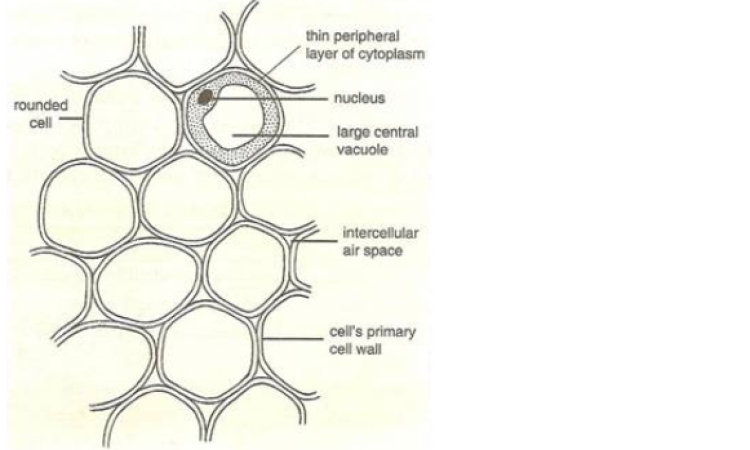
(b) Collenchyma
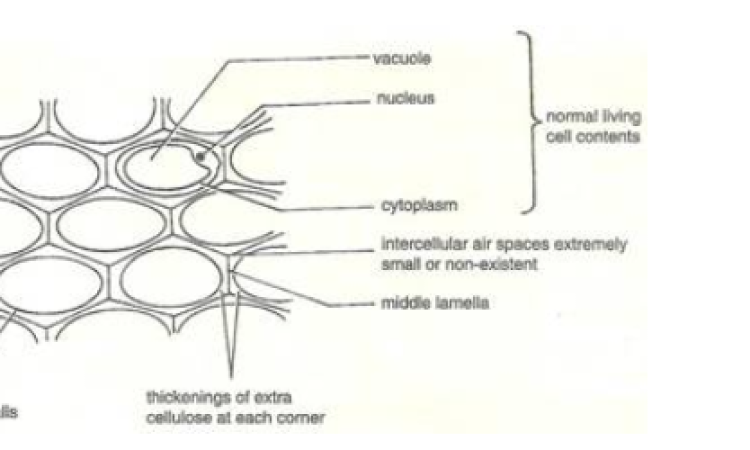
Solution 8:

Solution 9:
Xylem Tissue
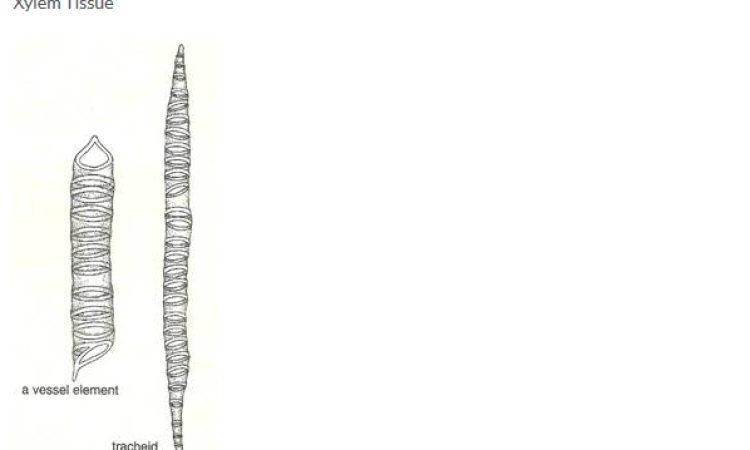
Solution 10:
Functions of Collenchyma:
(i) It provides mechanical support and elasticity.
(ii) It provides tensile strength to the plants.
Solution 11:
Sclerenchyma cells are dead cells and they are devoid of protoplasm. The cells walls of sclerenchyma are greatly thickened by lignin. The cells of sclerenchyma are closely packed without intercellular spaces.
Solution 12:
Xylem:
1. It conducts water and minerals.
2. Conducting channels or tracheary elements are tracheids and vessels.
Phloem:
1. It conducts organic solutes and food materials.
2. Conducting channels are sieve tubes.
Solution 13:
Tracheids:
1. Single celled.
2. The end walls remain intact.
Vessels:
1. Made up of a row of cells.
2. End walls get dissolved and become perforated.
Solution SAQ – 1:
The different types of elements present in the phloem are:
(i) Sieve tubes – Sieve tubes are slender, tube-like structures composed of elongated thin-walled cells, placed end to end. Their end walls are perforated by numerous pores and are called sieve plates.
(ii) Companion Cells – It is a small thin-walled cell containing dense and very active cytoplasm and large elongated nucleus.
(iii) Phloem parenchyma – These are thin-walled, living cells of parenchyma of phloem. They have two functions, storage and slow lateral conduction of food.
(iv) Phloem Fibre – These are thick-walled, elongated spindled shaped dead cells which posses narrow lumen. They provide mechanical strength to the tissue.
Solution SAQ – 2
Tracheary elements are the elements of xylem. Their function is to carry water and mineral salts in upward direction from the roots to different part of shoots.
Solution SAQ – 3
(i) Parenchyma Functions:
(a) The main function of parenchyma is to store and assimilate food.
(b) Transport of materials occurs through cells or cell walls of parenchyma cells.
(ii) Collenchyma Functions:
(a) It provides mechanical support and elasticity.
(b) It provides tensile strength to the plants.
(iii) Sclerenchyma Functions:
(a) It is mainly mechanical and protective in function.
(b) It gives strength, rigidity, flexibility and elasticity to the plant body.
Solution SAQ – 4
Parenchyma:
1. The tissue consists of thin-walled living cells.
2. It is distributed in almost all the parts of the plant body.
3. The living cells of parenchyma assimilate and store food. They also store waste products.
Collenchyma:
1. The tissue consists of cells having localised thickening in their cell walls.
2. It occurs mostly in the aerial parts of the plants and is restricted to the other layers.
3. Collenchyma is the chief mechanical tissue in parts of a young plant particularly in the young dicotyledonous stems.
Solution SAQ – 5:
Collenchyma:
1. It consists of living cells.
2. Its cells contain cytoplasm.
3. Its cell walls are cellulosic.
Sclerenchyma:
1. It consists of dead cells.
2. Its cells are empty.
3. Its cell walls are lignified.
Solution SAQ – 6
Xylem is composed of cells of four different types: 1. Tracheids; 2. Vessels or tracheae; 3. Xylem parenchyma and 4. Xylem Sclerenchyma. Except xylem parenchyma, all other xylem elements are dead and bounded by thick lignified walls. Vessels are shorter and wider than tracheids. Vessels are very long tube-like structures formed by a row of cells placed end to end. Tracheids are elongated cells with tapering ends. They also conduct water.
Solution SAQ – 7
Functions of Xylem:
(i) The main function of xylem is to carry water and mineral salts upward from the root to different parts of shoots.
(ii) Since walls of tracheids, vessels and sclerenchyma of xylem are lignified, they give mechanical strength to the plant body.
Solution SAQ – 8
Functions of Phloem:
Phloem transports photosynthetically prepared food materials from the leaves to the storage organs and later from storage organs to the growing regions of the plant body.
Solution SAQ – 9
The different types of plant tissues are:
1. Meristematic tissues – It is of three types: Apical, Lateral and Intercalary.
2. Permanent Tissue – It of two types: Simple and Complex tissues. Simple tissues are of three types – Parenchyma, Collenchyma and Sclerenchyma.
Complex tissues are of two types – Xylem and Phloem.
Solution SAQ – 10
Sieve tube elements do not have nuclei but have cytoplasm. They are dependent on adjacent companion cells which contains dense and very active cytoplasm and a large elongated nucleus.
Solution SAQ – 11
Functions of Epithelial tissues are:
(i) The cells of the body surface form the outer layer of skin. These cells protect the underlying cells from drying, injury, and chemical effects.
(ii) Inside the body, epithelial cells form lining of mouth and alimentary canal and protect these organs.
(iii) Epithelial tissues help in absorption of water and nutrients in small intestine.
(iv) Some epithelial tissues perform secretory function such as sweat, saliva in skin and mouth cavity.
Solution SAQ – 12
(i) Striated Muscles – It occur in the muscles of limbs, body wall, face, neck, etc. Striated muscles present in tongue, pharynx, diaphragm and upper part of oesophagus are called visceral straited muscles.
(ii) Smooth Muscles – Smooth muscles are found in the walls of the hollow (tubular) visceral organs except that of the heart. They occur in the wall of alimentary canal and internal organs, ducts of glands, urogenital ducts and blood vessels.
(iii) Cardiac Muscles – The cardiac muscles occur in the heart.
Solution SAQ – 13:
(a) Neuron – Nervous Tissue
(b) Dendrite – Nervous Tissue
(c) Cilia – Ciliated Epithelium
(d) Collagen fibres – Connective Tissue
(e) Elastin fibre – Connective Tissue
Solution SAQ – 14
(a) Osteoblast – It provides shape to the body.
(b) Chondroblast – It provided support and flexibility to the body parts.
(c) Goblet Cells – It is a mucus secreting epithelial cell which secrets mucus.
(d) Neuron – The dendrites receive impulses and the axon takes impulses away from the cell body.
(e) Muscle Cell – They undergo rapid contraction for locomotion.
Solution SAQ – 15
Two characteristics of nerve cells are:
(i) They are highly specialised unit cells.
(ii) Neurons have the ability to receive stimuli from within or outside the body and to conduct (send) impulses (signals) to different parts of the body.
Solution SAQ – 16
Bone – It provides skeletal support to the body.
Cartilage – It provides support and flexibility to the body parts.
Ligament – It connects bones to bones.
Solution SAQ – 17:
(a) Adipose tissues.
(b) Ciliated epithelium.
Solution SAQ – 18
Functions:
(i) It transports nutrients, hormones and vitamins to the tissues and transports excretory products from the tissues to the liver and kidney.
(ii) The RBCs carry oxygen to the tissues for the oxidation of food stuff.
(iii) WBCs fight disease by engulfing and destroying foreign bodies.
Solution SAQ – 19
The different tissues in animals are:
(i) Epithelial Tissues – These are the protective tissues of the animal body. Depending upon the shape and function of the cells, the epithelial tissues are classified as follows:
a. Squamous epithelium.
b. Cuboidal epithelium.
c. Columnar epithelium.
d. Glandular epithelium.
e. Ciliated epithelium.
(ii) Muscular Tissues – The muscular tissues form the contractile tissues and are made up of muscle cells. On the basis of their location, structure and function, there are three types of muscular tissues:
a. Striated muscles.
b. Smooth muscles.
c. Cardiac muscles.
(iii) Connective Tissues – The connective tissues are specialised to connect and anchor various body organs. They are of five types:
a. Aerolar connective tissue.
b. Dense regular connective tissue.
c. Adipose tissues.
d. Skeletal tissues.
e. Fluid connective tissues.
(iv) Nervous Tissues – These tissues are specialised to transmit messages within our body. Brain, spinal cord and nerves are all composed of nervous tissues.
Solution SAQ – 20:
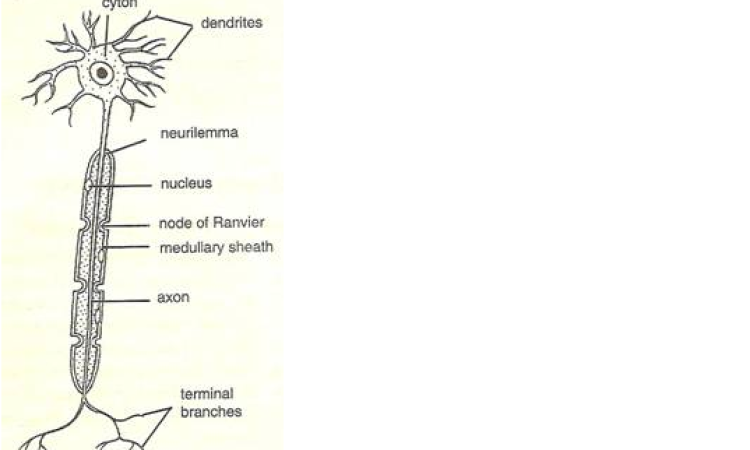
Solution SAQ – 21:
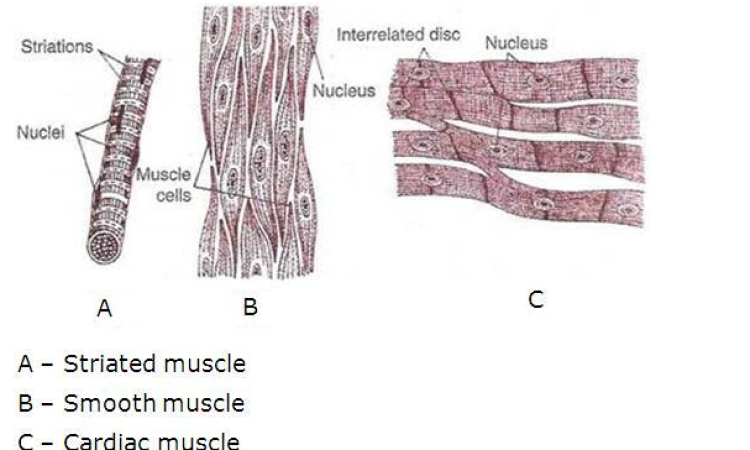
Solution LAQ – 1:
Simple tissues – These tissues are composed of cells which are structurally and functionally similar.

There are three types of simple tissues:
(i) Parenchyma – Parenchyma cells are living and posses the power of division. The cell wall is thin and encloses a dense cytoplasm which contains a small nucleus and surrounds a large central vacuole.
(ii) Collenchyma – It tissues also consists of living cells. It is characterized by the deposition of extra cellulose at the corners of the cells. In collenchymas, intercellular spaces are generally absent. Collenchyma cells are elongated in shape. They often contain a few chloroplasts.
(iii) Sclerenchyma – Sclerenchyma cells are dead cells and they are devoid of protoplasm. The cells walls of Sclerenchyma are greatly thickened by the deposition of lignin. The cells of sclerenchyma are closely packed without intercellular spaces.
Solution LAQ – 2:
Meristematic tissues are the tissues in which the cells divide continuously and help in increasing the length and girth of the plant.
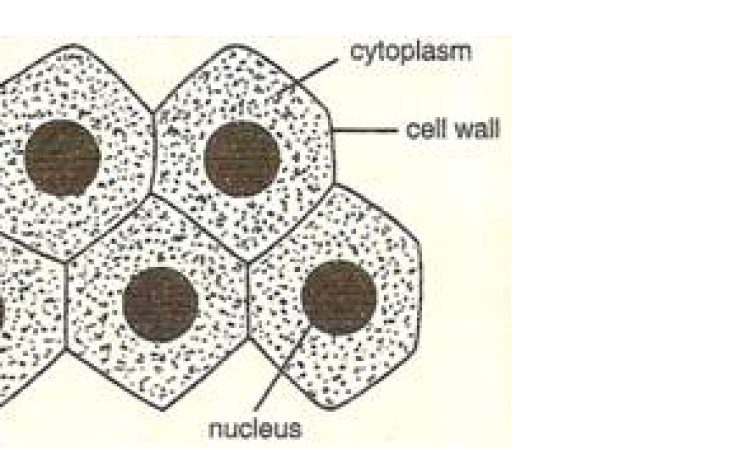
According to their position in the plant, meristems are of three types:
a) Apical Meristems – These are situated at the growing tip of the stems and roots and increase the height of the plant.
b) Lateral Meristems – These are found beneath the bark and in vascular bundles of dicot roots and stems. These are responsible for the growth of cambium and hence increases the girth of the plant.
c) Intercalary Meristems – They are located at the base of leaves or internodes or below the nodes. It increases the length of the plant.
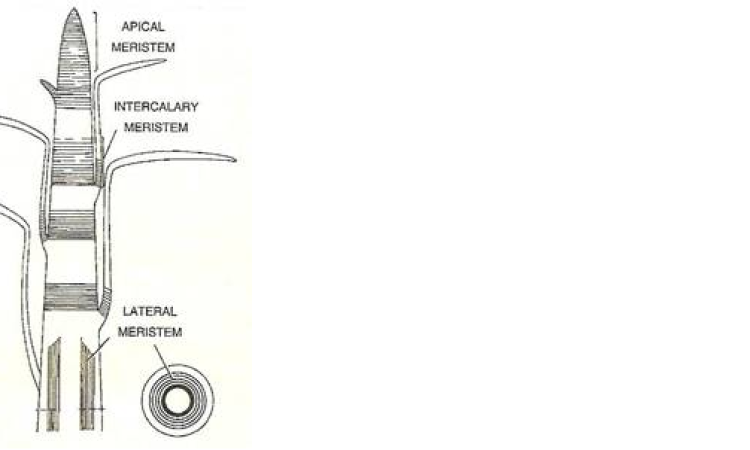
Solution LAQ – 3:
Simple tissues – These tissues are composed of cells which are structurally and functionally similar.
There are three types of simple tissues:
(i) Parenchyma – Parenchyma cells are living and posses the power of division. The cell wall is thin and encloses a dense cytoplasm which contains a small nucleus and surrounds a large central vacuole.

(ii) Collenchyma – It tissues also consists of living cells. It is characterized by the deposition of extra cellulose at the corners of the cells. In collenchymas, intercellular spaces are generally absent. Collenchyma cells are elongated in shape. They often contain a few chloroplasts.

(iii) Sclerenchyma – Sclerenchyma cells are dead cells and they are devoid of protoplasm. The cells walls of sclerenchyma are greatly thickened by the deposition of lignin. The cells of sclerenchyma are closely packed without intercellular spaces.
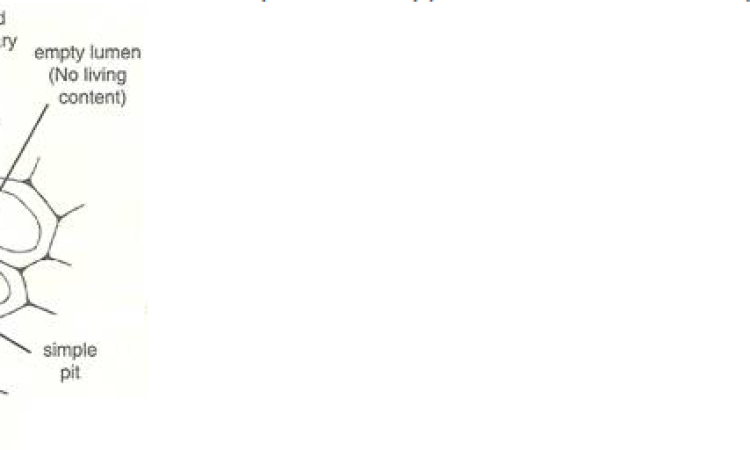
Best Ways to score good marks in Exam in short time
More Resources for Class 9:
P.S. Verma and V.K. Agarwal Solutions NCERT SolutionsMathsScienceSocialEnglishHindiRD Sharma